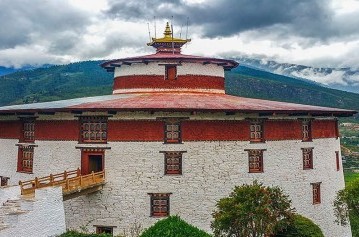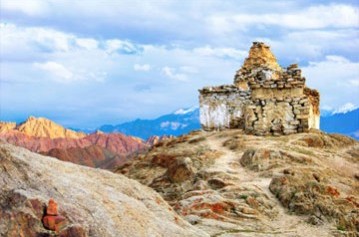Experience the rich cultural heritage and breathtaking landscapes of Bhutan on this comprehensive 10-day tour. Your adventure begins with a spectacular flight into Paro, followed by a scenic drive to Thimphu, Bhutan’s capital. En route, enjoy views of the confluence of the Thimphu and Paro rivers and visit the historic Tschogang Lhakhang. In Thimphu, explore the local crafts bazaar and visit landmarks such as the Institute for Zorig Chusum, Textile Museum, Buddha Point, King's Memorial Chorten, and the impressive Trashichhoedzong.
Journey to Gangtey (Phobjikha) through the scenic Dochula Pass, stopping at Wangdue Phodrang. In Gangtey, marvel at the vast valley and visit the Gangtey Goempa monastery. Continue to Trongsa, crossing the Pele-la pass and visiting the Chendbji Chorten and Trongsa Dzong. In Bumthang, explore the Kurje Lhakhang, Jambey Lhakhang, Tamshing Lhakhang, Jakar Dzong, and the Lhodrak Kharchhu Monastery.
Drive to Punakha, where you’ll visit the stunning Punakha Dzong and explore the local village. Then, head back to Paro, stopping at the Chimi Lhakhang temple and enjoying the scenic drive. In Paro, visit the National Museum and Rinpung Dzong, and take an excursion to the iconic Taktshang Monastery (Tiger’s Nest). Conclude your trip with a visit to the historic Drukgyel Dzong and the ancient Kyichu Lhakhang temple.
This tour offers an in-depth exploration of Bhutan's culture, history, and natural beauty, leaving you with unforgettable memories of the Land of the Thunder Dragon.
- Day 01 Arrival in Paro and Drive to Thimpu (55 KMS / 1½ HRS DRIVE)
- Day 02 Sightseeing in Thimpu
- Day 03 Thimpu - Gangtey (150 KMS / 05 HRS DRIVE)
- Day 04 Gangtey - Trongsa
- Day 05 Trongsa - Bumtang
- Day 06 Bhumtang Sightseeing
- Day 07 Bumtang – Punakha (205 KMS / 07 HRS DRIVE)
- Day 08 Punakha - Paro (120 KMS / 4½ HRS DRIVE APPROX)
- Day 09 Paro, Taktshang Monastery or Tiger’s Nest
- Day 10 Departure from Paro
The flight to Paro is one of the most spectacular in entire Himalayas. Flying along the Himalayan range from Kathmandu, the journey offers fascinating views and an exciting descent into the Kingdom. Bhutan’s first gift, as you disembark from the aircraft will be cool, clean fresh mountain air. After immigration formalities and baggage collection, you will be met by our representative, and afterwards drive to Thimphu, the capital town of Bhutan with enroute stop at Chuzom, the confluence of Thimphu and Paro rivers. Three different style of stupas; Tibetan, Nepalese and Bhutanese adorn this confluence. Shortly before reaching Chuzom, you will see on your left TschogangLhakhang, “the temple of the excellent horse”. It is a private temple, built in 15th century, as the result of visitation from Balaha, the excellent horse, a manifestation of Chenrezig, the compassionate Buddha.
On arrival in Thimphu, check into the hotel. The capital town of Bhutan and the centre of Government, religion and commerce, Thimphu is a unique city with unusual mixture of modern development alongside ancient traditions. With the population of about 90,000 it is perhaps still the world’s only capital city without a traffic light.
Evening an exploratory walk around Thimphu Main Street and market area. Also visit theLocal Crafts Bazaar, to browse through example of Bhutan's fine traditional arts. Here you can buy hand-woven textiles, Thangkha paintings, masks, ceramics, slate and wood carvings, jewellery, interesting items made from local materials.
Overnight at the hotel in Thimphu (Altitude 2400m).
After breakfast, sightseeing in Thimphu valley including visit to the following: The Institute for Zorig Chusum (commonly known as the Painting School) where students undergo a 6-year training course in Bhutan’s 13 traditional arts and crafts. Later visit Textile Museum, which provides insight into Bhutan’s one of the most distinct art form.
After lunch take a short drive (15 km) to Pangri Zampa, 16th century one of the oldest monasteries in Bhutan located just north of Thimphu. Here is a monastic school where Buddhist student’s monks learn Lamaism and astrology based on Buddhist philosophy.
Afterwards visit to Buddha Point (Kuensel Phodrang). Located at a short drive from Thimphu city centre, visitors can get a good overview of the Thimphu valley from the Buddha point (KuenselPhodrang). You can pay your obeisance and offer prayers to the Buddha, the largest statue in the country and then walk around and take a glimpse of the valley.
King's Memorial Chorten continuously circumambulated by people, murmuring mantras and spinning their prayer wheels. Construction of this landmark was the idea of Bhutan’s third king, His Majesty Jigme Dorji Wangchuk (“the father of modern Bhutan”) who has wished to erect monument to world peace and prosperity. Completed in 1974 after his untimely death, it serves both as a memorial to the Late King and as a monument to peace.
Later visit to Trashichhoedzong: This impressive fortress/monastery houses Secretariat building, the throne room of His Majesty, the King and various government offices. It is also the summer residence of Chief Abbot and central monk body.
Overnight at the hotel in Thimphu.
After breakfast, check-out from the hotel & drive Gangtey (Phobjikha) enroute visiting Dochula Pass (Altitude 3080m). In Bhutan, the passes are marked by a large Bhutanese Chorten and prayer flag. Dochula pass offers the most spectacular view over the high peaks of the eastern Himalayas on a clear day. And also via Wangdue Phodrang, where you can visit the local market and explore newly developed town. The district of Wangdue Phodrang is also famous for its bamboo products, slate and stone carvings. Further ahead pass through dense forests and oak, rhododendron tress, reaching at Gangtey (Phobjikha).
The valley of Gangtey is one of the most beautiful spots in Bhutan. The surprise of finding such a wide, flat valley without any trees after the hard climb through dense forests is augmented by an impression of vast space, and extremely rare experience in Bhutan where most of the valleys are tightly enclosed.
Afternoon take a walk around Gangtey village and visit Gangtey Goempa, the only Nyingmapa monastery in this region.
Overnight at the hotel in Gangtey
After breakfast drive to Bumthang crossing Pele-la pass (3300m/10830 ft) via Trongsa. The Pela La (pass) is marked by a large white Chorten prayer flags. There is an abrupt change in vegetation at this point, with mountain forest replaced by high altitude dwarf bamboo. Stop enroute at Chendbji Chorten, patterned on Kathmandu’s Swayambhunath Stupa, with eyes panted at four cardinal points.
After lunch at Trongsa visit Trongsa Dzong, built in 1648 it was the seat of power over central and eastern Bhutan. Also visit Ta Dzong, recently opened fort in Trongsa. The Ta Dzong, a cylindrical stone structure rising five stories, was built in 1652 by Chogyal Minjur Tempa, after more than 350 years, it has been resurrected into a classy museum, that represents a tasteful blend of tradition and modernity.
Overnight at Hotel in Trongsa
After breakfast, drive to Bumthang. Further 68 km drive across the Yutong-la pass (3,400m/ 11,155 ft) finally brings you to wide open cultivated Bumthang valley.
Upon arrival; check into the hotel. Bumthang is the general name given to combination of four valleys – Chumey, Choekhor, Tang and Ura with altitude varying from 2,600m to 4,000m. It is home to many of prominent Buddhist temples and monasteries.
Overnight at hotel in Bumthang.
After breakfast proceed for the tour of Bumthang valley: Visit Kurje Lhakhang, where the saint Padma sambhava subdued a local demon and left his body imprint on a rock, the Jambey Lhakhang (7th century temple), Tamshing Lhakhang (housing some of the oldest wall paintings in Bhutan) and Jakar Dzong (administrative center of the region). Stroll in the village, visit the little handicrafts shop at the entrance to the town, and perhaps take refreshments at a local restaurant.
Afternoon take a short hike to Lhodrak Kharchhu Monastery: Located above the main town, about 3 km from Chamkhar town, the monastery was founded by Namkhai Nyingpo Rinpoche in 1984 who was recognized at a very young age by H.H. the 14th Dalai Lama and H.H. 16th Karmapa as the reincarnation of a Tibetan lama.
The monastery has become part of an extensive effort to preserve and revitalize Tibetan culture. The monk regular curriculum includes reading, memorizing the daily prayers, learning dharma dances, drawing mandalas, learning the melodies of sacred rituals, learning the use of ceremonial instruments and the art of making sacrificial objects, grammer, poerty, karika along with the basics of contemplation and instruction on the different stages of tantra.
Overnight at Hotel in Bumthang
After breakfast, check-out from the hotel and drive to Punakha, the old capital town of Bhutan.
After checking into hotel, proceed to visit Punakha Dzong, a massive structure built at the junction of two rivers. It was the capital of Bhutan until 1955, and still serves as the winter residence of the monk body.
Evening can be spent exploring Punakha village located right on the bank of river.
Overnight at the hotel in Punakha.
After breakfast, take a short excursion to Chimi Lhakhang (from hotel it is about 15 minutes’ drive till motorable road and then walk starts through paddy fields and villages. This is total about 1½ hour walk, including both way). The Chimi Lhakhang, situated on a hillock in the centre of the valley, also known as the temple of fertility. It is widely believed that couples who do not have children and wanting one, if they pray at this temple, they are usually blessed with a child very soon. The trail leads across rice fields to the tiny settlement of Pana, meaning ‘field’. A walk through the village near the temple will give you rare glimpses into the daily life and lifestyle of the villagers.
Later continue drive to Paro.
On arrival in Paro, check into the hotel. After lunch, proceed to visit Ta Dzong, originally built as Watchtower, which now houses National Museum. The extensive collection includes antique Thangkha paintings, textiles, weapons &armour, household objects and a rich assortment of natural and historic artifacts.
Ta Dzong visit immediately followed by a short walk down the trail to visit Rinpung Dzong (ParoDzong), meaning (“fortress of the heap of jewels”), which has a long and fascinating history. Along the wooden galleries lining the inner courtyard are fine wall paintings illustrating Buddhist lore such as four friends, the old man of long life, the wheel of life, scenes from the life of Milarepa, Mount. Sumeru and other cosmic Mandala.
After breakfast excursion to Taktshang Monastery or Tiger’s Nest (approx. 5 hours walk): It is one of the most famous of Bhutan’s monasteries, perched on the side of a cliff 900m above the Paro valley floor. It is said that Guru Rinpoche arrived here on the back of a tigress and meditated at this monastery and hence it is called ‘Tiger’s Nest’. This site has been recognised as a most sacred place and visited by ShabdrungNgawangNamgyal in 1646 and now visited by all Bhutanese at least once in their lifetime. On 19 April, 1998, a fire severely damaged the main structure of building but now this Bhutanese jewel has been restored to its original splendour.
Afternoon drive to Drukgyel Dzong, a ruined fortress where Bhutanese warriors fought Tibetan invaders centuries ago. The snowy dome of sacred Chomolhari, "mountain of goddess'' can be seen in all her glory from the approach road to the Dzong.
Evening, visit the 7th century Kyichu Lhakhang, one of the 108 temples built in the Himalayas by Tibetan King, Songtsen Gampo. The building of this temple marks the introduction of Buddhism in Bhutan.
Overnight at the hotel in Paro.
After early breakfast at the hotel, drive to the airport for flight to your onward destination. Our representative will help you with exit formalities and then bid you farewell.





